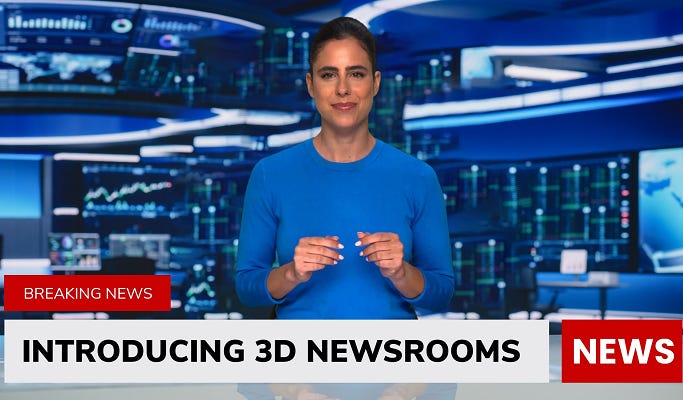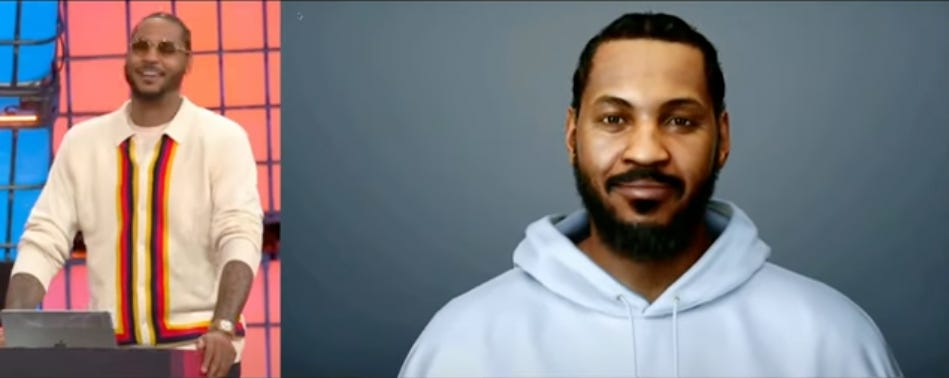What roles are virtual humans likely to fill? Most of the early use cases were expected to be putting a humanlike face on customer service chatbots. This is definitely happening though not quickly expectations have changed.
Every time I speak with a virtual human company lately, they tell me about some other use case they believe will be far more powerful in the near term. Digital twins are an interesting example of new ideas gaining interest.
NBA star Carmello Anthony partnered with Soul Machines to create his digital twin, Digital Melo. “I could have sent my Digital Melo here today and did this instead of me coming. That’s a different way of me interacting with people,” said Anthony at the Collision 2022 conference.
Soul Machines CEO Greg Cross commented, “How do we give fans the opportunity to experience their heroes and feel like they can have that interaction and personal connection? How can we give amazing people like Melo the opportunity to further their causes and touch more people, influence more people, and make more of a difference in life.”
This is about engagement, and it’s also about scalability. You can take an individual and give them more reach (and also more market intelligence, but that topic is for another day). Another interesting scalability use case is the virtual newscaster. This can be a digital twin of a television news personality, or it can be a completely fictitious virtual newscaster associated with a particular media outlet.
Virtual Newscaster
You can read the news. You can listen to the news. Often you want to watch the news. It can be more engaging and include visuals that offer greater insight, depth, interest to a news story.
This is one reason why television news became such a dominant force in the pre-internet era. However, it is costly to have humans in a studio, and they can present far fewer news stories in any given period of time than having multiple writers publish articles. Television (and video) news operates within significant constraints at high cost.
Virtual newscasters change the math in this equation. These virtual newscasters may not initially carry the same weight or engagement as a human on the other side of the screen, but they also doesn’t have the same scalability limitations or the negative biases that invariably accompany news personalities.
Voicebot experimented with a couple of virtual newscasters solutions recently. DeepBrain AI provides an example of a virtual human with a full torso in a relatively static pose. It is designed for the virtual newscaster to be on screen left and to show visuals on screen right.
More recently, HourOne introduced 3D virtual newsrooms. The solution offers more camera movement for visual interest. The view can zoom in, zoom out, pan, and tilt to maintain the viewer’s attention and is controllable by the video producer. It also enables the use of multiple locations and formats to show visual content.
What it Means
The virtual human market is still very early and ripe for innovation and experimentation. It is unclear whether consumers will adopt virtual human newscasters in large numbers. However, it is hard not to expect a news media company to arise that exclusively consists of writers and virtual human broadcasters.
You could use AI to write the first drafts of the stories, have humans edit them, and feed the content into a virtual human video production platform. Then it’s just publish and you have video news programs delivered through the most popular digital channels at a fraction of the cost of today’s bloated media business models.
Vertical vs Horizontal
So far, we’ve seen examples primarily for horizontal (landscape) video formats. Given that video is so dominant on mobile, it would seem likely that this will accelerate into the mass market as vertical videos on TikTok, YouTube shorts, and Snapchat. Well, that’s if consumers actually want news on those channels and not just a laugh. Maybe entertainment industry news will be the first to gain traction in social media with vertical video.
I will be looking at virtual human newscaster adoption patterns not just of the market overall but of the vertical versus horizontal delivery channels.






